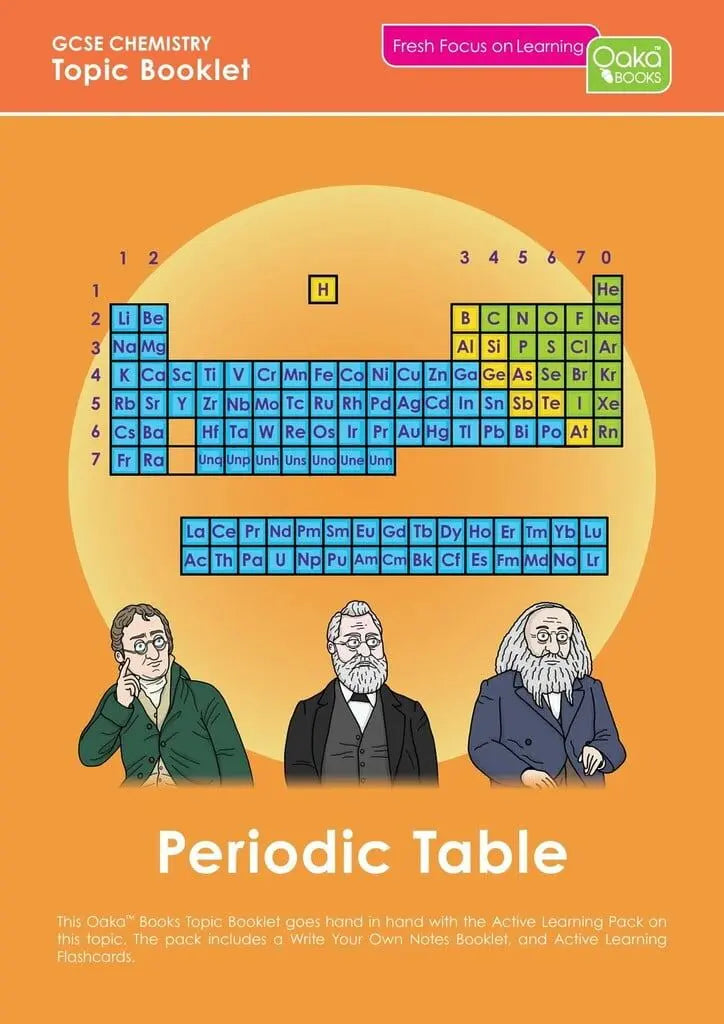
Periodic Table GCSE / KS4 Chemistry
✅ Learn or revise complicated concepts easily
✅ Information broken down into short chunks
✅ Full-colour illustrations on every page
Arguably the basis of chemical investigation, the Periodic Table has developed over many years. This Periodic Table revision pack will help students get to grips with the different elements, where they can be found in the table and why they are in those positions. This revision pack makes learning the core information quick and simple.
Broken down into bite-sized chunks, this Periodic Table GCSE revision guide will help students understand (and remember!) the key facts about the Periodic Table, its history and uses.
Each numbered section is clearly laid out and illustrated to aid understanding, making it more accessible to all students, irrespective of their reading ability, with beautiful images to highlight each key point.
Written by Dr Timothy Danks, former Head of Science at The Oratory School and a tutor for over 25 years, the Periodic Table revision pack brings GCSE revision to life in a visual and highly memorable way, helping students understand and apply this knowledge to their study of chemistry.
Topics Covered Include:
Glossary of keywords (this is especially large for this topic as there are so many vital words for pupils to know and understand)
The scientists who discovered the Periodic Table
How the table developed
The structure of the Periodic Table
Finding the atomic number and relative atomic mass
Alkali metals and their properties
Group 7 Halogens
Displacement reactions
Noble Gases
Transition metals
Uses of different elements in different groups
Plus, the Topic Pack contains 52 active learning questions & answer flashcards!
This is a complicated topic that is made clear and easy to understand in this fully illustrated topic pack.
What is the Periodic Table?
The periodic table is a tabular arrangement of chemical elements organised on the basis of their atomic number, electron configurations and chemical properties. The elements are arranged in rows and columns according to their increasing atomic number, with elements having similar chemical properties being placed in the same vertical column, known as a group or family.
The elements in the same row, known as a period, have similar electron configurations. The table also includes information about the element’s symbol, atomic number, and atomic weight. The periodic table has been expanded numerous times since its inception in the 19th century when scientists first began to systematically study chemical elements. The earliest version of the table was created by the Russian chemist Dmitry Mendeleev in 1869. Mendeleev arranged the known elements in order of increasing atomic weight and noticed that certain elements shared similar chemical properties. He left gaps in his table where he predicted new elements would be discovered, and his predictions were duly confirmed by the discovery of those elements.
Since Mendeleev’s original table was created, scientists have continued to discover new elements and refine the table to better reflect the elements’ properties. The modern periodic table includes 118 elements, and scientists continue to explore the potential existence of additional elements beyond those currently known.
Why is the Periodic Table Useful?
Learning about the periodic table for GCSE is very useful, not only because questions could be based around it but because it’s foundational to modern chemistry.
The Periodic Table organises the elements in a logical and easy-to-understand format. By arranging elements according to their atomic number and electron configurations, the table allows for the prediction of the chemical properties of an element based on its position within the table.
It allows for the identification of trends in the properties of elements. For example, elements in the same group or family of the table have similar chemical properties, while elements in the same period have similar electron configurations.
Additionally, the table helps to explain the behaviour of elements in chemical reactions. The table can be used to predict how elements will react with one another, and it can also be used to identify the products of a chemical reaction.
The table helps in the discovery of new elements. Mendeleev left gaps in his original table where he predicted new elements would be discovered, and his predictions were subsequently confirmed by the discovery of those elements.
The Periodic Table is widely used in many fields of science and technology, such as chemistry, biology, physics, geology, metallurgy, and materials science.
The periodic table has become an essential tool for organizing and understanding chemical elements, and it continues to play a critical role in many scientific disciplines. Periodic table GCSE learning materials are essential for GCSE/KS4 chemistry.
WHAT'S IN EACH PACK
- Topic Booklet
- Write Your Own Notes Booklet
- Active Learning Q&A Flashcards







